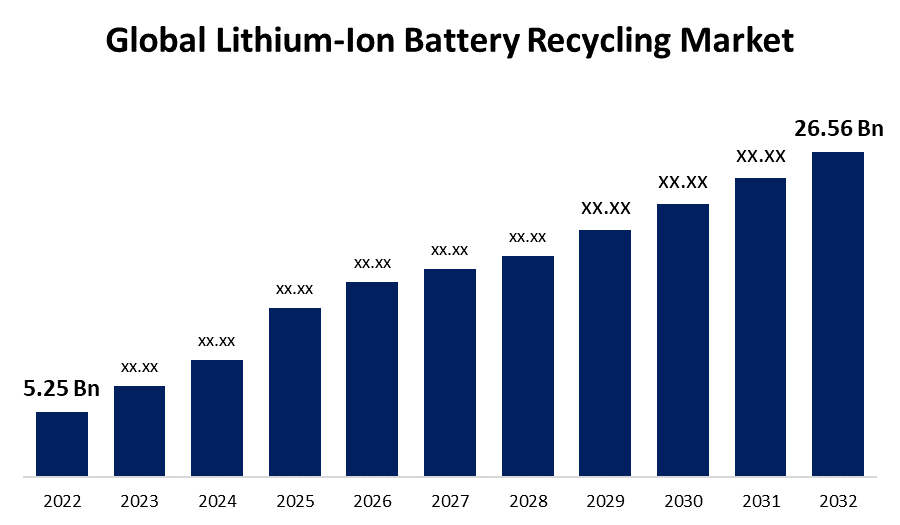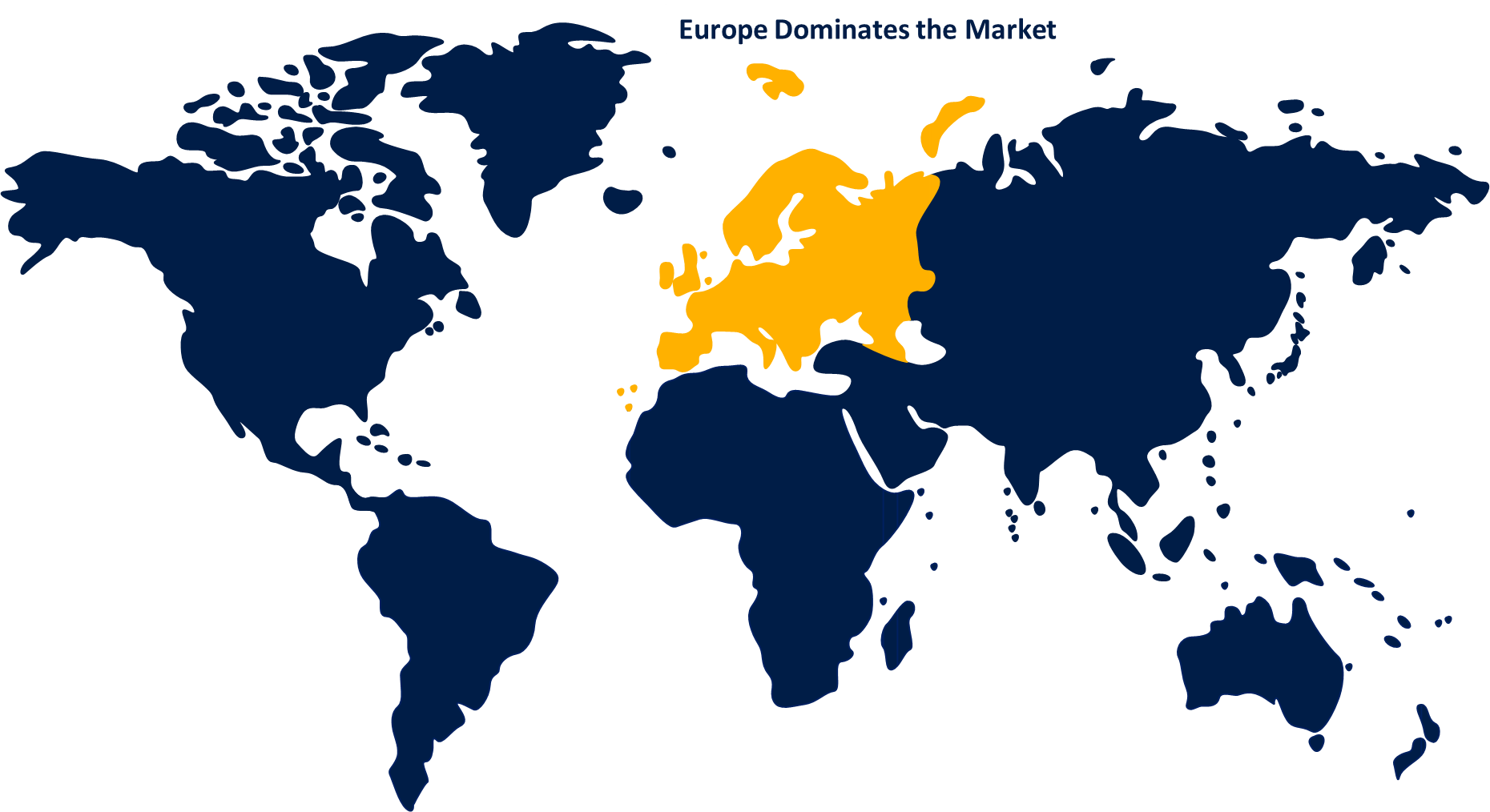Global Lithium-Ion Battery Recycling Market Size, Share, and COVID-19 Impact Analysis, By Source (Automotive and Non-automotive), By Component (Active Material and Non-active Material), By Recycling Process (Hydrometallurgical Process, Pyrometallurgical Process, and Physical/Mechanical), By Battery-Chemistry (Lithium-nickel Manganese Cobalt, Lithium-iron Phosphate, Lithium-manganese Oxide, Lithium-titanate Oxide, and Lithium-nickel Cobalt Aluminum Oxide), By Region (North America, Europe, Asia-Pacific, Latin America, Middle East, and Africa), Analysis and Forecast 2023 – 2032
Industry: Energy & PowerGlobal Lithium-Ion Battery Recycling Market Insights Forecasts to 2032
- The Lithium-Ion Battery Recycling Market was valued at USD 5.25 Billion in 2022.
- The Market is growing at a CAGR of 17.6% from 2022 to 2032
- The Worldwide Lithium-Ion Battery Recycling Market is expected to reach USD 26.56 Billion by 2032
- Asia-Pacific is expected to grow the highest during the forecast period

Get more details on this report -
The Global Lithium-Ion Battery Recycling Market is expected to reach USD 26.56 Billion by 2032, at a CAGR of 17.6% during the forecast period 2022 to 2032.
Market Overview
Lithium-ion battery recycling is an essential process aimed at recovering valuable materials from used or end-of-life batteries, reducing environmental impact, and conserving valuable resources. These batteries are widely used in various applications, including electric vehicles, portable electronics, and renewable energy storage systems. The recycling process typically involves several stages, including collection, disassembly, sorting, and treatment. Through advanced technologies, such as mechanical shredding, pyrometallurgical, and hydrometallurgical processes, valuable components like lithium, cobalt, nickel, and other metals can be extracted and reused in the production of new batteries or other applications. Recycling lithium-ion batteries not only reduces the demand for mining raw materials, but it also helps mitigate the environmental hazards associated with battery disposal, such as the release of toxic chemicals. Furthermore, it promotes a circular economy and supports the sustainable growth of the battery industry.
Report Coverage
This research report categorizes the market for lithium-ion battery recycling market based on various segments and regions and forecasts revenue growth and analyzes trends in each submarket. The report analyses the key growth drivers, opportunities, and challenges influencing the Lithium-ion battery recycling market. Recent market developments and competitive strategies such as expansion, product launch, and development, partnership, merger, and acquisition have been included to draw the competitive landscape in the market. The report strategically identifies and profiles the key market players and analyses their core competencies in each sub-segments of the lithium-ion battery recycling market.
Global Lithium-Ion Battery Recycling Market Report Coverage
| Report Coverage | Details |
|---|---|
| Base Year: | 2022 |
| Market Size in 2022: | USD 5.25 Billion |
| Forecast Period: | 2022-2032 |
| Forecast Period CAGR 2022-2032 : | 17.6% |
| 2032 Value Projection: | USD 26.56 Billion |
| Historical Data for: | 2018-2021 |
| No. of Pages: | 200 |
| Tables, Charts & Figures: | 100 |
| Segments covered: | By Source, By Component, By Recycling Process, By Battery-Chemistry, By Region and COVID-19 Impact Analysis |
| Companies covered:: | American Battery Technology Company, ACCUREC Recycling GmbH, Cirba Solutions, Contemporary Amperex Technology Co., Limited, Ecobat, Fortum, GEM Co., Ltd., Glencore, Li-Cycle Corp., Neometals Ltd., Redwood Materials Inc., RecycLiCo Battery Materials Inc., Stena Recycling, TES, The International Metals Reclamation Company, Umicore, and others. |
| Pitfalls & Challenges: | COVID-19 Empact, Challenge, Future, Growth, & Analysis |
Get more details on this report -
Driving Factors
The lithium-ion battery recycling market is being driven by several key factors due to the increasing adoption of electric vehicles (EVs) is a significant driver. As EV sales continue to rise, the demand for battery recycling grows, as these vehicles rely heavily on lithium-ion batteries. Government regulations and policies promoting sustainable practices and waste reduction are pushing for greater recycling efforts. Many countries are implementing strict regulations regarding the disposal of batteries, encouraging the development of recycling infrastructure. The growing awareness of environmental issues and the desire to reduce carbon footprints are encouraging individuals and businesses to opt for battery recycling. Moreover, the rising costs of raw materials, such as lithium, cobalt, and nickel, are making recycling economically viable. By recovering these valuable materials, companies can reduce their dependency on mining and lower production costs. Overall, the increasing demand for EVs, regulatory support, environmental consciousness, and cost considerations are driving the growth of the lithium-ion battery recycling market.
Restraining Factors
While the lithium-ion battery recycling market shows promising growth, there are several restraints to consider. The lack of proper collection infrastructure and logistics poses a challenge. Efficient collection and transportation networks are necessary to ensure the smooth flow of used batteries to recycling facilities. The complex nature of battery chemistry and design makes recycling technically challenging and costly. As new battery chemistries and designs emerge, recycling technologies need to keep pace. The risk of safety hazards during the recycling process, such as thermal runaway or the release of toxic chemicals, requires careful handling and specialized facilities. Overall, the economics of recycling must be balanced, as the cost of recycling must compete with the relatively low cost of extracting raw materials through mining.
Market Segmentation
- In 2022, the non-automotive segment accounted for around 62.5% market share
On the basis of the source, the global lithium-ion battery recycling market is segmented into automotive and non-automotive. The non-automotive segment has emerged as the holder of the largest market share in the lithium-ion battery recycling industry. Several factors contribute to the dominance of this segment because the rapid proliferation of portable electronic devices, such as smartphones, tablets, and laptops, has led to a significant volume of used lithium-ion batteries in the consumer electronics sector. As these devices often have shorter lifespans compared to electric vehicles, there is a higher turnover of batteries, creating a substantial recycling demand. The increasing deployment of energy storage systems in sectors like renewable energy and grid stabilization has bolstered the non-automotive segment. These systems utilize large-scale lithium-ion batteries that require proper recycling and resource recovery. Additionally, the stringent regulations and sustainability initiatives in the electronics industry have further propelled the growth of the non-automotive lithium-ion battery recycling market.
- In 2022, the hydrometallurgical process segment dominated with more than 28.7% market share
Based on the type of recycling process, the global lithium-ion battery recycling market is segmented into hydrometallurgical process, pyrometallurgical process, and physical/mechanical. The hydrometallurgical process segment has emerged as the holder of the largest market share in the lithium-ion battery recycling industry. This dominance can be attributed to due to the hydrometallurgical process offers a highly efficient and effective method for recovering valuable metals from spent batteries. This process involves leaching the batteries with suitable solvents or acids to dissolve the metals, followed by precipitation or solvent extraction to separate and recover them. It has demonstrated a high metal recovery rate, making it a preferred choice for recycling companies. The hydrometallurgical process is versatile and adaptable to different battery chemistries and compositions, allowing for the recycling of a wide range of lithium-ion batteries. Additionally, this process is environmentally friendly compared to pyrometallurgical methods, as it operates at lower temperatures and minimizes emissions. The combination of high efficiency, versatility, and environmental sustainability has propelled the hydrometallurgical process segment to hold the largest market share in the lithium-ion battery recycling market.
Regional Segment Analysis of the Lithium-Ion Battery Recycling Market
- North America (U.S., Canada, Mexico)
- Europe (Germany, France, U.K., Italy, Spain, Rest of Europe)
- Asia-Pacific (China, Japan, India, Rest of APAC)
- South America (Brazil and the Rest of South America)
- The Middle East and Africa (UAE, South Africa, Rest of MEA)
Europe held the largest market share with more than 38.5% in 2022.

Get more details on this report -
Based on region, Europe has emerged as the leader in the lithium-ion battery recycling market, holding the largest market share. Several factors contribute to Europe's dominant position in this industry because this region has implemented stringent regulations and policies regarding battery disposal and recycling, promoting sustainable practices. Robust legislation, such as the european union’s waste electrical and electronic equipment (WEEE) directive, mandates the proper recycling and treatment of batteries. Europe boasts a well-developed recycling infrastructure with specialized facilities and advanced technologies. The presence of established recycling companies and collaborations between manufacturers, recyclers, and research institutions further enhances the recycling ecosystem. Additionally, Europe's strong focus on renewable energy and electric mobility has driven the demand for lithium-ion batteries, leading to a parallel emphasis on recycling to support a circular economy. These factors have propelled Europe to the forefront of the lithium-ion battery recycling market.
Recent Development
- In February 2023, A memorandum of understanding was signed by Contemporary Amperex Technology Co., Limited, Mercedes-Benz, and GEM Co., Ltd., with the aim of recycling cobalt, nickel, manganese, and lithium metals from used Mercedes-Benz EV batteries and transforming them into battery cathode materials through remanufacturing processes.
Competitive Analysis:
The report offers the appropriate analysis of the key organizations/companies involved within the global lithium-ion battery recycling market along with a comparative evaluation primarily based on their product offering, business overviews, geographic presence, enterprise strategies, segment market share, and SWOT analysis. The report also provides an elaborative analysis focusing on the current news and developments of the companies, which includes product development, innovations, joint ventures, partnerships, mergers & acquisitions, strategic alliances, and others. This allows for the evaluation of the overall competition within the market.
List of Companies:
- American Battery Technology Company
- ACCUREC Recycling GmbH
- Cirba Solutions
- Contemporary Amperex Technology Co., Limited
- Ecobat
- Fortum
- GEM Co., Ltd.
- Glencore
- Li-Cycle Corp.
- Neometals Ltd.
- Redwood Materials Inc.
- RecycLiCo Battery Materials Inc.
- Stena Recycling
- TES
- The International Metals Reclamation Company
- Umicore
Key Target Audience
- Market Players
- Investors
- End-Users
- Government Authorities
- Consulting and Research Firm
- Venture Capitalists
- Value-Added Resellers (VARs)
Market Segment
This study forecasts revenue at global, regional, and country levels from 2022 to 2032. Spherical Insights has segmented the global lithium-ion battery recycling market based on the below-mentioned segments:
Lithium-Ion Battery Recycling Market, By Source
- Automotive
- Non-automotive
Lithium-Ion Battery Recycling Market, By Component
- Active Material
- Non-active Material
Lithium-Ion Battery Recycling Market, By Recycling Process
- Hydrometallurgical Process
- Pyrometallurgical Process
- Physical/Mechanical
Lithium-Ion Battery Recycling Market, By Battery Chemistry
- Lithium-nickel Manganese Cobalt
- Lithium-iron Phosphate
- Lithium-manganese Oxide
- Lithium-titanate Oxide
- Lithium-nickel Cobalt Aluminum Oxide
Lithium-Ion Battery Recycling Market, Regional Analysis
- North America
- US
- Canada
- Mexico
- Europe
- Germany
- UK
- France
- Italy
- Spain
- Russia
- Rest of Europe
- Asia Pacific
- China
- Japan
- India
- South Korea
- Australia
- Rest of Asia Pacific
- South America
- Brazil
- Argentina
- Rest of South America
- Middle East & Africa
- UAE
- Saudi Arabia
- Qatar
- South Africa
- Rest of Middle East & Africa
Need help to buy this report?